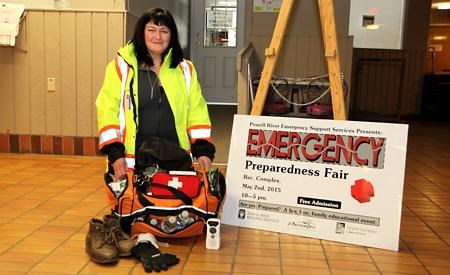With the earthquake in Nepal on Saturday, April 25, serving as such a graphic reminder, profoundly life-changing incidents can strike without warning. Survival can be dependent upon the investment of time and resources made prior to an emergency.
To that end, emergency measures will be highlighted at an exposition this weekend to provide examples and advice on how to be ready for everything ranging from the simplest emergency to a full-blown disaster.
Connie Keiver is coordinator of the Emergency Preparedness Fair, which will be held from 10 am to 5 pm on Saturday, May 2, at the Powell River Recreation Complex. Keiver has been a member of Powell River Emergency Support Services (ESS), the organization hosting the fair, for about five years. A similar event was run seven years ago in Powell River by St. John Ambulance to celebrate its 100th year, but this is the first time that ESS has held such an event.
Keiver said one of the advantages of emergency preparedness is that it helps instill processes and procedures that become second nature in times of emergency, where panic and disruption are commonplace.
“As you prepare for one emergency you are typically prepared for them all,” Keiver said.
There may be some specific initiatives, such as preparing for earthquakes, where people will want to take special measures like ensuring bookcases are fixed to walls and that heavy items in kitchens are in lower drawers and shelving. This may be different than planning for house fires, for example, but generally, the items required for living without a fully-functioning home, such as having enough food and water, plus a first aid kit, are general requirements for most significant emergency disruptions.
In past, the recommendation has been to prepare for 72 hours of independent living before help arrives, but Keiver said realistically, it may be a week or two before there is a coordinated relief effort here in a major disaster. The Lower Mainland and lower Vancouver Island, where the bulk of BC’s population is situated, will receive precedence. Given the limitations of transportation access to Powell River, damage to the ferry terminals and airport would complicate outside access, so any initiatives that can be taken here for families to provide the necessities for themselves could make for better outcomes. Most of the preparations for emergencies involve common sense initiatives to make sure the necessities of life are readily at hand.
“It gives people the opportunity to think about what really fits into their lifestyles and what they need to do,” Keiver said. “It’s a really good idea to sit down when you are not stressed to figure out what stuff you really, truly need and then start working at it from there.”
Keiver said in terms of medications, for example, she regularly rotates them through her emergency “grab and go” bag so that if she is faced with an emergency situation, she is not left with expired, stale, out-of-date prescriptions. So it goes with other consumables, such as gas for electric generators.
It is not only important to have an emergency first aid kit, but also a first aid book, just in case the emergent situation prompts a blank about how to attend to fixing an injury.
It is also vital to ensure that there is emergency preparedness for pets. The family dog or cat is probably going to be less than pleased if they have nothing to eat. There will be people at the emergency preparedness fair to help residents prepare for those eventualities.
Keiver said efforts were made, in planning the event, to cover all bases, to ensure there is a wide spectrum of information.
“It’s not just preparing for the emergency event,” she said. “It’s preparing beforehand to lessen the impact and mitigate some of them.” Initiatives such as ensuring there are no large trees that are going to drop on the family house in a windstorm, or securing or removing other structures that could create havoc in an earthquake, can go a long way toward enhancing survivability.
Keiver said in times of disaster there is an expectation that people will come out of the woodwork to provide relief.
“People need to prepare for an event where there is no one coming,” she said. “How are you going to make out? If it’s a really large event, there won’t be enough resources to go around to every single community and person that needs it. This is where we need to stand up as a community and say we are responsible and that we are going to take care of ourselves.”
Keiver said having a grab and go kit is an essential component of emergency preparedness, “just in case you have to [get] out in a real big hurry, so that you are not stuck with absolutely nothing. You have everything that you need.”
Assembling the grab and go bag does not need to be an onerous task. Keiver said the majority of the items on the grab and go list, which is available here, are already owned and available in the household.
Keiver said she always asks if people want to be making life-threatening decisions on the spur of the moment when they are already neck-deep in it. In an emergency situation, it is typically preferable to have thought about it in advance to ensure people’s choices fit their prospective needs when life is severely disrupted.
While watching news coverage brings large emergency events to the forefront, Keiver said the fair is not just geared to being ready for cataclysmic occurrences.
“Every day you get up, your feet hit the floor; what type of day are you going to have? You can face everything from little, small emergencies, to great big ones. The fair is to make everyone aware of what can occur.”
For comprehensive details on local emergency information, readers can visit Powell River Regional Emergency Program’s webpage.



